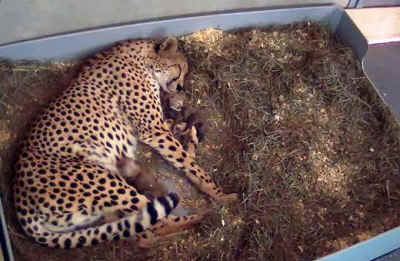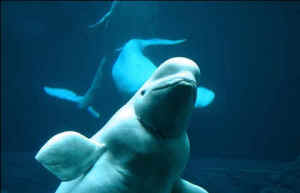
Zoos trying to play Noah
An Animal Rights Article from All-Creatures.org
FROM
Earth in Transition
July 2012
If we want to protect wildlife, there’s basically just one right thing to do: leave these animals alone, stop stealing them for profit, stop appropriating their homes, and stop killing off the oceans....Zoos, aquariums and marine circuses aren’t the solution to the problem. In every way, they’re just part of the problem.

Cheetah mom with kittens at the National Zoo
In the Book of Genesis, when civilization is about to get wiped out, Noah is instructed to take two of every species into his ark so they can repopulate the planet. A few lines further on, there’s an alternate version that involves two pairs of the “unclean” animals and seven pairs of the “clean” ones.
With a bit of divine intervention, two pairs or even seven pairs might have worked to repopulate wildlife back then. But it certainly wouldn’t today – at least not according to Sarah Long, director of the Population Management Center at the Association of Zoos and Aquariums. Zoos generally agree that you need at least 20 animals of a species for a viable breeding program. Leslie Kaufman writes in the New York Times about the growing efforts of zoos to run emergency breeding programs.
With extinctions rising and habitats being destroyed, zoos are trying to breed about 160 endangered species in captivity. But while mating in the wild seems largely primal and effortless, in captivity it can be anything but.
Eighty-three percent of those species in North American zoos are not meeting the targets set for maintaining their genetic diversity, the Association of Zoos and Aquariums reports. In the case of cheetahs, fewer than 20 percent of those in North American zoos have been able to reproduce.
The National Zoo in Washington, DC, spends $350,000 a year on breeding cheetahs. The big cats are generally uncooperative: "Finally, it was time to bring in the female. She seemed mystified by the male cheetah’s eagerness and failed to assume a mating position. The encounter fizzled."
But all of these attempts to take dominion over wildlife are a complete waste of time and money.
“I’d be happier about captive breeding if I thought it helped wild cheetahs,” said Luke Hunter, president of Panthera, a nonprofit group that works on global conservation efforts for big cats in the wild, including cheetahs. “Free of threats, they breed like rabbits in the wild. They don’t need supercostly assisted reproduction — they need a place to roam.”
The fact is zoos aren’t in the business of conservation of animals; they’re in the business of conservation of zoos.
Breeding programs are not just about preserving species; they are about ensuring that zoos thrive, too. Until the 1970s, zoos could capture animals they wanted to exhibit. But a growing awareness of the vulnerability of many species led to treaties. And the Endangered Species Act of 1973 restricted imports of threatened animals, even by zoos. So zoos began running coordinated breeding programs for threatened species.
So, while there may certainly be people who work at zoos because they want to save wildlife, they’re kidding themselves if they think this is the way to do it.
That’s because zoos are not, and never were, about protecting animals; they’re about entertaining humans. And as long as your business is premised on that, then just about everything you do has to be about your bottom line: entertaining humans in order to stay in business.
No zoo can seriously believe that it’s going to save the wildlife of Africa by breeding a few more cheetahs or any other endangered species, including elephants, rhinos and chimpanzees, any more than the game hunting ranches of Texas are, as they claim, “saving” antelope and zebra by being in the business of breeding them and having people pay big bucks to shoot them.
Breeding animals in captivity, especially cats, is a very complicated operation. Kaufman explains that cheetah mating behavior is entirely different from, for example, clouded leopards, who pair up with their mates early in life. Cheetahs don’t pair off at all. And with clouded leopards, if you introduce older cats to each other, they get very stressed and the male may even kill the female.
Skirting the rules at the Georgia Aquarium

The perfect example of “let’s pretend to be helping animals” is the latest project of the Georgia Aquarium. They have captured 18 beluga whales from where they live in the Sea of Okhotsk in eastern Russia, and are planning to fly them halfway around the world to be put on display in the United States.
All of this is being done in the name of conservation. But again, what the Georgia Aquarium is in the business of conserving is its own business (which includes mounting one of the cheesiest dolphin shows of all time). And last month, one of the belugas at the Georgia Aquarium gave birth. Days later, the baby died. Rather than admit that breeding belugas in captivity is fraught with problems, the aquarium took no responsibility and even tried to argue that this was quite normal in the wild.
What the aquarium industry wants is a healthy bank of captive whales so
they can have a guaranteed source of new belugas for the future. But
captures of wild-caught cetaceans in U.S. waters ceased in the 1990’s after
public outcry. So the aquarium is skirting around this by capturing them in
Russian waters and then bringing them here. (Even so, to import them to the
U.S. , they’ll need clearance from federal agencies, which is why they and
other aquariums have already mounted a concerted public relations effort.)
Kidnapping young belugas from a healthy population (and yes, that’s the
right word for what they’re doing), flying them half way round the world,
and dropping them into a small tank where they can entertain (or, as the
aquarium would say, “educate”) an unwitting crowd of visitors has nothing to
do with protecting animals and conserving species.
Frankly, we humans don’t really know much more about conservation than
Noah might have done if he were trying to figure out whether to go with the
directive that said to take two pairs, or the other one, a few lines later,
that said to take seven pairs.
If we want to protect wildlife, there’s basically just one right thing to
do: leave these animals alone, stop stealing them for profit, stop
appropriating their homes, and stop killing off the oceans.
Zoos, aquariums and marine circuses aren’t the solution to the problem. In every way, they’re just part of the problem.
Return to Animal Rights Articles







